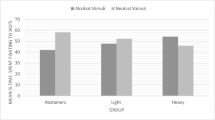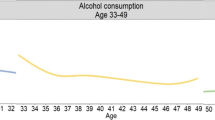Abstract
Introduction
Addiction models theorise that alcohol attention bias (AAB) for alcohol-related cues develops through a process of classical conditioning and that attentional processes shift from controlled to automatically modulated responses. At the point of automaticity, alcohol cues grab the attention of problem drinkers beyond conscious control and can trigger alcohol use. To fully understand this shift, AAB should be thought of as developing on a continuum from when alcohol use commences. Despite this, little is known about AAB differences in younger populations who are at an early stage in their exposure to alcohol and related cues.
Rationale
This study compared AAB for alcohol cues across age groups (early adolescent, late adolescent, and young adult) and drinking groups (heavy drinkers, light drinkers, and non-drinkers) to provide a cross-sectional examination of differences in AAB and their relationship to alcohol use and age.
Methods
Eye tracking was employed to measure several elements of attentional processing during exposure to alcohol cues. Differences across age groups and drinking groups were examined.
Results
Differences in controlled attention were found between heavy and light drinkers. As age increases, a shift towards automaticity can be seen with alcohol-related cues attracting the attention of young adult drinkers earlier in stimulus presentation.
Conclusions
This cross-sectional approach provides an insight into AAB across a key developmental period. It highlights that influential processes underpinning AAB may change and how rapidly it may approach automaticity. The implications of these findings are discussed.

Similar content being viewed by others
References
Albery I, Sharma D, Noyce S, Frings D, Moss A (2015) Testing a frequency of exposure hypothesis in attentional bias for alcohol-related stimuli amongst social drinkers. Addict Behav 1:68–72
Allen JP, Litten RZ, Fertig JB, Babor T (1997) A review of research on the Alcohol Use Disorders Identification Test (AUDIT). Alcohol Clin Exp Res 21(4):613–619
Bauer D, Cox WM (1998) Alcohol-related words are distracting to both alcohol abusers and non-abusers in the Stroop colour-naming task. Addiction 93(10):1539–1542
Cox WM, Blount JP, Rozak AM (2000) Alcohol abusers’ and nonabusers’ distraction by alcohol and concern-related stimuli. Am J Drug Alcohol Abuse 26(3):489–495
Cox WM, Yeates GN, Regan CM (1999) Effects of alcohol cues on cognitive processing in heavy and light drinkers. Drug Alcohol Depend 55(1–2):85–89
Cox WM, Brown MA, Rowlands LJ (2003) The effects of alcohol cue exposure on non-dependent drinkers’ attentional bias for alcohol-related stimuli. Alcohol Alcohol 38(1):45–49
De Houwer J (2006) What are implicit measures and why are we using them? In: Wiers RW, Stacy AW (eds) Handbook of implicit cognition and addiction. Sage Publications Inc., London & New Delhi
Duka T, Townshend JM (2004) The priming effect of alcohol pre-load on attentional bias to alcohol related stimuli. Psychopharmacology 176(3):353–361
Ebrel C, Wiers WR, Pawelczack S, Rinck M, Becker ES, Lindenmeyer J (2013) Approach bias modification in alcohol dependence: do clinical effects replicate and for whom does it work best. Dev Cogn Neurosci 4:38–51
Field M, Mogg K, Zetteler J, Bradley BP (2004) Attentional biases for alcohol cues in heavy and light social drinkers: the roles of initial orienting and maintained attention. Psychopharmacology 176(1):88–93
Field M, Christiansen P, Cole J, Goudie A (2007) Delay discounting and the alcohol Stroop in heavy drinking adolescents. Addiction 102(4):579–586
Johnsen BH, Laberg JC, Cox WM, Vaksdal A, Hugdahl K (1994) Alcoholic subjects’ attentional bias in the processing of alcohol-related words. Psychol Addict Behav 8(2):111–115
Laidlaw, K. & Risko, E. & Kingstone, A. (2012). A New Look at Social Attention: Orienting to the Eyes Is Not (Entirely) Under Volitional Control. Journal of experimental psychology. Human perception and performance. 38:1132–43
MacLeod, Colin & Mathews, Andrew & Tata, Philip. (1986). Attentional Bias in Emotional Disorders. Journal of abnormal psychology. 95:15–20
Melaugh McAteer A, Curran D, Hanna D (2015) Alcohol attention bias in adolescent social drinkers: an eye tracking study. Psychopharmacology 232(17):3183–3191
McCusker C (2006) Towards understanding loss of control: an automatic network theory of addictive behaviours. In: Munafó M, Albery I (eds) Cognition addiction. Oxford University Press, Oxford
Miller MA, Fillmore MT (2011) The effect of image complexity on attentional bias towards alcohol related images in adult drinkers. Addiction 105(5):883–890
Moss AC, Albery IP, Siddiqui I, Rycroft N (2013) Attentional bias for alcohol related stimuli among belief based and non-belief based non-drinkers. Eur Addict Res 19(6):299–302
Noël X, Colmant M, Van Der Linden M, Bechara A, Bullens Q, Hanak C et al (2006) Time course of attention for alcohol cues in abstinent alcoholic patients: the role of initial orienting. Alcohol Clin Exp Res 30(11):1871–1877
Robinson TE, Berridge KC (1993) The neural basis of drug craving: an incentive sensitization theory of addiction. Brain Res Rev 18(3):247–291
Ryan F (2002b) Attentional bias and alcohol dependence: a controlled study using the modified Stroop paradigm. Addict Behav 27(4):471–482
Sharma D, Albery IP, Cook C (2001) Selective attentional bias to alcohol related stimuli in problem drinkers and non-problem drinkers. Addiction 96(2):285–295
Stetter F, Chaluppa С, Ackermann К, Straube E, Mann К (1994) Alcoholics’ selective processing of alcohol related words and cognitive performance on a stroop task. Eur Psychiatry 9(2):71–76
Thompson K, Stockwell T, Leadbeater B, Homel J (2014) Association among different measures of alcohol use across adolescence and emerging adulthood. Addiction 109(6):894–903
Townshend J, Duka T (2001) Attentional bias associated with alcohol cues: differences between heavy and occasional social drinkers. Psychopharmacology 157(1):67–74
Vollstädt-Klein S, Loeber S, Von Der Goltz C, Mann K, Kiefer F (2009) Avoidance of alcohol-related stimuli increases during the early stage of abstinence in alcohol-dependent patients. Alcohol Alcohol 44(5):458–463
Zetteler JI, Stollery BT, Weinstein AM, Lingford-Hughes AR (2006) Attentional bias for alcohol-related information in adolescents with alcohol-dependent parents. Alcohol Alcohol 41(4):426–430
Author information
Authors and Affiliations
Corresponding author
Ethics declarations
The ethics committee at the School of Psychology, Queen’s University Belfast, approved the study.
Rights and permissions
About this article
Cite this article
McAteer, A.M., Hanna, D. & Curran, D. Age-related differences in alcohol attention bias: a cross-sectional study. Psychopharmacology 235, 2387–2393 (2018). https://doi.org/10.1007/s00213-018-4935-3
Received:
Accepted:
Published:
Issue Date:
DOI: https://doi.org/10.1007/s00213-018-4935-3




